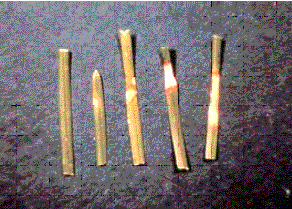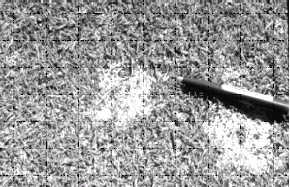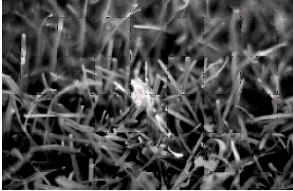Reports on Plant Diseases |
RPD No. 407 - Dollar Spot of Turfgrasses
|
July 1999
|
[ Symptoms ] [ Disease
Cycle ] [ Control ]
| Dollar spot of turfgrasses is believed to be caused
by species of the fungi Lanzia and Moellerodiscus (formerly
known as Sclerotinia homoeocarpa). It has been reported in
most areas of the United States. During warm moist weather in the
northern part of this country dollar spot is a serious disease of
creeping bentgrass, Kentucky bluegrass, annual bluegrass, and fine-leaf
fescues. All lawn and fine turfgrasses grown in the Midwest may be
attacked. Perennial ryegrass and tall fescue are potential hosts with
Bermudagrass and zoysiagrasses the most severely affected southern
turfgrasses. The disease occurs during warm (60 to 85 F or 15 to 39
C), humid weather, particularly in turf deficient in nitrogen. Drought
stress increases the severity of disease, although leaf wetness within
the canopy is also required.
Back to Top
|

Figure
1.
Sclerotinia dollar spot lesions on Kentucky bluegrass.
|
Symptoms
The disease appears as round, brown spots (about the size of a
silver dollar) in closely cut bentgrass and bermudagrass putting
greens. As the disease develops, the spots change from brown to
the color of straw and become somewhat sunken: hence, the descriptive
term "dollar spot." On coarse, taller, lawntype grasses
(for example, bluegrasses, fescues, and ryegrasses) the spots may
reach four to eight inches in diameter. Dollar spot is distinguished
from most turfgrass diseases by the characteristic girdling lesions
on the leaf blades of live plants at the margin of the affected
areas. The lesions may be up to an inch long, often at or near the
leaf tip. They are bleached white to light tan with a dark brown,
reddish brown, or purplish border (Figure 1). The lesions usually
extend across the blades of Kentucky bluegrass and fine-leaf fescues.
On coarser grasses, such as tall fescue, the lesions tend to occur
along the margins of the leaves.
Under close mowing (as on putting or bowling greens), the diseased
spots rarely enlarge beyond 2 1/2 inches in diameter. If fungicides
are not applied, the spots may become so numerous that they emerge
and produce large, irregular, sunken areas of straw-colored dead
turf (Figure 2). When dew is present on the blades of grass on overcast
days or early in the morning and the dollar-spot fungi are active,
mycelia (a white cobwebby or cottony growth) of the causal fungi
may be seen on the diseased turf (Figure 3). Guttation fluid (dew)
increases the process of infection. Some mycelia may persist under
the leaf sheaths, but most disappear as they are dried by the wind
and sun. The mycelia of the dollar spot fungi are often confused
with spider webs. Spider webs, however, are in a single plane, whereas
dollar spot is three dimensional. When turf is maintained at a higher
cut of 1 to 2 1/2 inches, the diseased areas are noticeably more
irregular in outline and larger, with some spots four to eight inches
in diameter. The spots may coalesce to give diseased turf a drought-stricken
appearance.
The rhizomes, stolons, and roots are not invaded by the dollar
spot fungi, however, a fungus-produced toxin affects the uptake
of water and nutrients and causes the roots to thicken, stop growing,
and turn brown. The replacement roots soon are similarly affected.
This is why dollar spot is most severe in dry soils deficient in
nitrogen.
|

Figure
2.
Dollar spot on bentgrass.
|

Figure
3.
Sclerotinia fruiting on Kentucky bluegrass.
|
Disease Cycle
Dollar spot fungi survive unfavorable growing periods as black,
paper-thin flakes (stromata) on foliage surfaces and in soil, and
as dormant mycelia in living or dead turfgrass tissues. In spring
or early summer, when the temperature reaches 50 to 60 F (10 to
15 C), the mycelia and stromata resume mycelial growth. The fungi
enter plants through cut leaf tips and natural openings (stomates)
when plant surfaces are wet. Maximum disease development usually
occurs between 70 and 80 F (21 to 26 C) in dry soils where there
is a buildup of thatch and soil nitrogen and where potassium levels
are low. Infected tissue first appears water-soaked and dark, becoming
light tan when dry. If the nights are cool and dry soon after infection
has occurred, or if cultural and chemical control measures are applied
promptly, damage is limited to the leaf blades, and disease turf
usually recovers quickly–especially if it is growing rapidly.
If nights are warm and damp, if heavy dews persist after infection,
and if fungicides are not applied, the dollar-spot fungi rapidly
kill plant tissues, and diseased areas may require weeks or months
to recover. When turfgrasses are maintained with adequate nitrogen,
potash, and water, less dollar spot occurs, and recovery is more
rapid. The fungi spread to new areas mostly through transport of
infected sod or clippings by waterland wind or on shoes, hoses,
mowers, other turf equipment, golf carts, and animals.
|
Back to Top
Control
- Maintain adequate to moderate fertility based on soil tests
and the recommended fertilization program for your area and the grass
or grasses being grown.
- Thorough irrigation in the early morning is recommended as
it removes exudate and dew which may be necessary for fungal growth.
Not watering during the day will allow a ‘leaf drying' period to
curtail fungal activity. Maintain sharp mower blades and mow when leaves
are dry.
- Prune or remove nearby dense trees and shrubs to reduce shade
and enhance the movement of air over the turf.
- When establishing a new turfgrass area, provide for adequate surface
drainage by grading for a slope of two to four percent and filling
in depressions to achieve a smooth, uniform surface.
- Recent tests show that Kentucky bluegrass varieties most resistant
to dollar spot are ‘Moonlight', ‘Sidekick', ‘Award',
‘Misty', ‘America', ‘Ascot', ‘Odyssey', ‘Total
Eclipse', ‘Quantum Leap', ‘SR' 2100', and ‘Abbey.'
Most perennial ryegrasses have some level of resistance to dollar
spot. At the top of the list in recent tests are ‘Catalina', ‘Edge',
‘Laredo', and ‘Sunshine.' Others deserving mention are ‘Caddieshack',
‘Cutter', ‘Manhattan 3', ‘Pennfine', and ‘SR 4200.'
Creeping bentgrass varieties most resistant to dollar spot are: ‘L-93'
, ‘Pennlinks', ‘Seaside', ‘Penn A4', and ‘Penn G2.'
- Mow at the maximum mower height (1 1/2 to 3 inches for upright,
lawn-type grasses; 1/2 inch or less for bentgrasses and bermudagrass).
- On golf greens, remove guttation water (dew) in early morning
by dragging a hose or long bamboo pole over the wet grass or by hosing
the turfgrass down lightly with water.
- With proper cultural controls, fungicide application should be
unnecessary. However, if problems have been evident in the past,
begin applying a protective fungicide when air temperatures reach 65
to 70 F. Apply at frequent intervals according to the label for the
specific fungicide used, particularly during moist weather in the spring,
summer, and fall. Many broad spectrum fungicides are ineffective because
of the development of resistance by the causal fungi.
Back to Top
|
For further information concerning diseases of crucifers
and other vegetables, contact Mohammad Babadoost, Extension Specialist in Fruit
and Vegetable Diseases, Department of Crop Sciences, University of Illinois at
Urbana-Champaign. University of Illinois
Extension provides equal opportunities in programs and employment.
|



